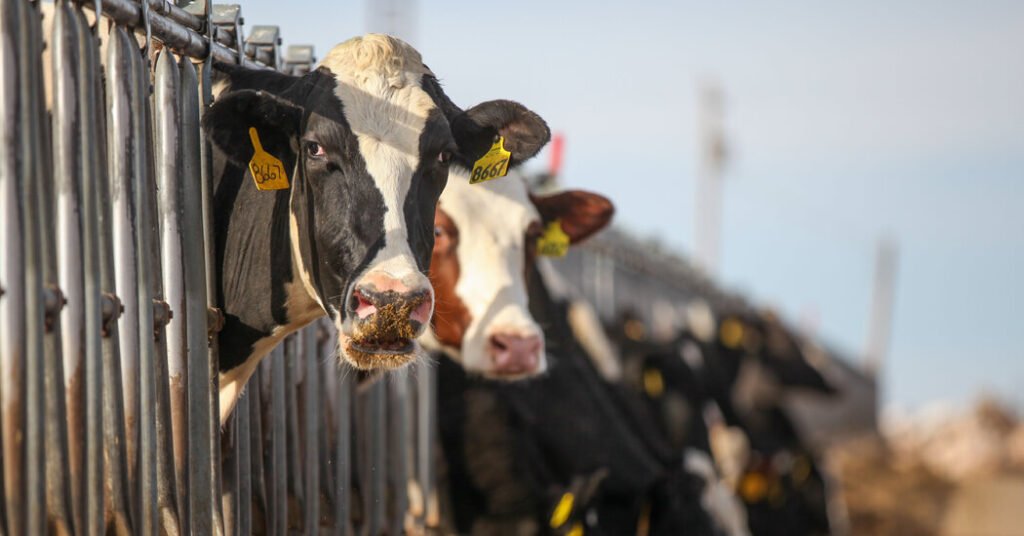A extremely deadly type of avian influenza, or chicken flu, has been confirmed in U.S. cattle in Texas and Kansas, the Department of Agriculture announced on Monday.
It’s the first time that cows contaminated with the virus have been recognized.
The cows seem to have been contaminated by wild birds, and useless birds had been reported on some farms, the company mentioned. The outcomes had been introduced after a number of federal and state companies started investigating reviews of sick cows in Texas, Kansas and New Mexico.
In a number of circumstances, the virus was detected in unpasteurized samples of milk collected from sick cows. Pasteurization ought to inactivate the flu virus, specialists mentioned, and officers harassed that the milk provide was secure.
“At this stage, there isn’t a concern in regards to the security of the industrial milk provide or that this circumstance poses a threat to shopper well being,” the company mentioned in a press release.
Exterior specialists agreed. “It has solely been present in milk that’s grossly irregular,” mentioned Dr. Jim Lowe, a veterinarian and influenza researcher on the School of Veterinary Medication on the College of Illinois at Urbana-Champaign.
In these circumstances, the milk was described as thick and syrupy, he mentioned, and was discarded. The company mentioned that dairies are required to divert or destroy milk from sick animals.
The cattle infections come on the heels of the nation’s first detection of extremely pathogenic chicken flu in goats, which was announced by Minnesota officials last week.
To date, the flu samples from sick cows haven’t contained genetic mutations which might be identified to make the virus extra prone to infect people, the agriculture company mentioned, including that the chance to most of the people remained low.
“There’s nonetheless no trigger to panic,” mentioned Stacey L. Schultz-Cherry, a virologist and influenza knowledgeable at St. Jude Youngsters’s Analysis Hospital. “It simply seems to be prefer it’s one other spillover occasion resulting from contact with diseased wild birds.”
Nonetheless, she famous, cows weren’t regarded as among the many species that had been notably vulnerable to avian influenza, and the circumstances had been one other worrisome flip in a worldwide chicken flu outbreak that has devastated wild chicken populations over the previous few years.
The outbreak has been brought on by a brand new type of chicken flu virus, often known as H5N1, that emerged in Europe in 2020. Wild birds can unfold the virus, by their feces and oral secretions, to farmed poultry and different animals. Outbreaks typically flare up within the spring and summer time, when migrating birds are on the transfer.
Though avian influenza viruses are tailored to unfold primarily amongst birds, the brand new model of H5N1 has turn into so widespread in wild birds that it has additionally repeatedly unfold to mammals, particularly scavenging species, similar to foxes, which may feed on contaminated birds.
Infections of mammals, which give the virus new alternatives to evolve, are at all times a supply of some concern, Andrew Bowman, a molecular epidemiologist and influenza knowledgeable at Ohio State College, mentioned. Scientists have lengthy been involved {that a} chicken flu virus that advanced to unfold extra effectively amongst mammals, together with people, may set off the subsequent pandemic.
At this level, Dr. Bowman mentioned, it stays unclear whether or not the contaminated cows have all picked up the virus instantly from birds or whether or not the virus can be spreading from cow to cow.
“That’s a query that’s going to must get resolved rapidly,” he mentioned. “If we’ve got transmission cattle to cattle, that’s a special story. That actually makes me a little bit extra nervous.”
Further testing and evaluation are underway. “It is a quickly evolving scenario, and U.S.D.A. and federal and state companions will proceed to share further updates as quickly as info turns into accessible,” the company mentioned.
